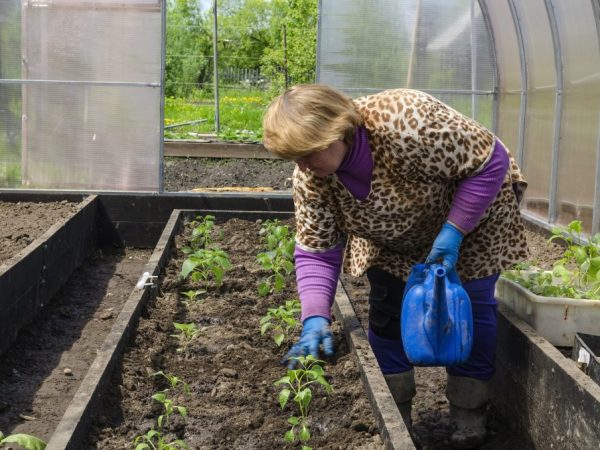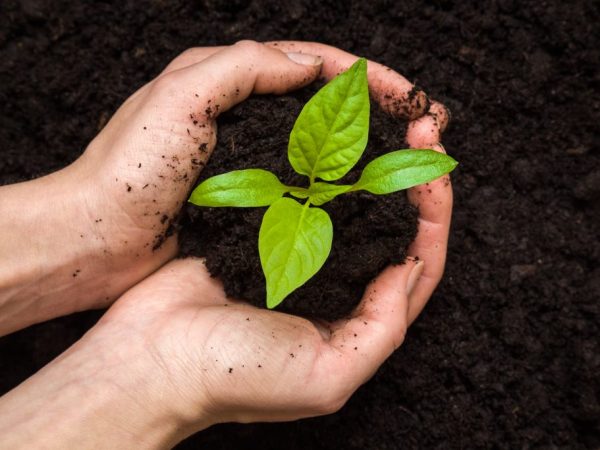Pinching pepper seedlings
Pinching pepper seedlings contributes to a rich harvest. The pinching procedure allows you to turn a thin and tall plant into a bush with a spreading crown. Flowers will appear on all branches, and then large fruits will grow. The fruits of pinched seedlings are large in size and excellent taste.

Pinching pepper seedlings
The benefits of pinching
Pinching or pinching pepper seedlings plays an important role in the formation of healthy vegetable plants that ripen above the ground. Shortening of the main shoot leads to a thickening of the stem and an increase in leaves.
Passionate, or pinching. - This is the process of removing excess growth on the bushes. Artificial regulation of the growth of the seedling crown allows you to increase the number of full-fledged fruit buds and accelerates the growth of the ovary.
Correctly pinched seedlings give a large, high-quality yield. This is due to the fact that the seedlings do not expend energy on growth, but give all the minerals to the fruit.
Benefits of pinned seedlings:
- The bushes treated in this way form a powerful root system, due to which the seedlings receive more moisture, and with it minerals.
- Fruits on pinched bushes are larger and thicker than on seedlings that have not been pinched.
- Seedling care (soil loosening, pest control, foliar and root dressing) is simplified due to easier access to the seedlings.
- The ovary on such bushes is gaining strength much faster, the harvest ripens faster.
- Removing the excess crown does not allow the development of fungal diseases (black rot on the fruit).
All bushes that have undergone pinching are distinguished by the strength of the branches and trunk, as well as resistance to the main varieties of mosaics. Less often, seedlings suffer from diseases resulting from thickening of plantings: bacterial cancer, gray rot and alternaria.
Rules and order of work
You need to pinch pepper seedlings only at a certain time. If you do not know the rules of agricultural technology for peppers, you can harm the plant. At the very least, the seedling will stop growing and shed its foliage. In the worst case, the bush will wither completely.
Too weak plants are not recommended to pinch. It is better to leave them to grow a little, otherwise the shoot may die or stop bearing fruit.
Choosing the time
The best time for the first pruning is as soon as the bush has formed 5 true leaves. Such plants have a developed root system and a height of about 10-15 cm (depending on the variety). Seedlings that have reached the age of 25-30 days are ready for pinching. At this time, the seedlings are almost ready to be transferred to a permanent place in the greenhouse.
At this time, they produce:
- pinching young shoots;
- shortening the apex;
- removal of the first, crown, bud.
At a more mature age, sterile shoots that have not formed flower buds and ovaries are removed, and the lower skeletal leaves are also cut off. The latter action is aimed at improving ventilation inside the bush and allows sunlight to warm up the fruits better.
At the moment when the crop ripens on the bush, you should also resort to pinching. This time, remove all the flowers and the ovary, which takes strength from the bush, but still is not able to ripen before the end of the season.
Pinching process

Remove by hand or tool
The pinching procedure is carried out either manually or with the help of nail scissors, scalpel or tweezers. Most gardeners prefer to remove shoots and buds with their fingers, because then the risk of damaging nearby growing leaves is minimal, and the recovery process is faster.
Pinch off as carefully as possible. If, following the removed part, a part of the surface shell of the stem is damaged, this area is completely removed.
Seedling pruning procedure
Plucking seedlings begins with the selection of skeletal branches. They should be 2-3 of the strongest and strongest shoots. Next, cut off the top that is hidden in the bosom after 5 true sheets. At the same time, the lower sheets are removed if they begin to wrinkle or turn yellow.
- The first pinching of peppers in seedlings is done when 2 full leaf rosettes have formed on the plant. Removal of the leaf bud leads to the formation of 2 full-fledged branches at the site of the shortening of the main stem. Buds appear on them after the first leaf.
- Such an ovary should not be left as it slows down the development of lateral shoots. This is the second pinching step. The buds are removed when they are still the size of a match head.
- The third pinching is the shortening of the side branches and pinching the tops on them. The action is carried out after the seedlings are planted in the ground, and 3-4 fruits are formed on each branch.
Any pruning, pinching and pinching is done in the evening, as well as in warm and dry weather. The beds with peppers must be watered, and the seedlings must be absolutely healthy.
Care of pinned plants
Caring for pinched seedlings consists in regular watering and feeding, as well as protection from external factors.
Watering
Shortening the stems and removing the buds is stressful for the seedlings, so they stop growing for a while and freeze. If the soil contains a sufficient amount of moisture, the process of regeneration of seedlings is faster.
Top dressing of the soil
After pinching at any time during the life of the seedlings, water the plants abundantly with warm water with the addition of potassium permanganate. The liquid should be light pink. Such fertilizer not only disinfects the soil, but also temporarily scares away pests living in the ground.
Foliar dressing
A day after pruning or pinching, a complex foliar feeding of seedlings is performed. This not only speeds up the adaptation process, but also allows new shoots to form faster.
Grassy plants are capable of yielding 30% more than untreated bushes. Ripening dates are shifted 5-7 days ago, which is especially important for gardeners in the northern regions.
What seedlings do not pinch
Some types of peppers do not need to be pinched. Seedlings of low-growing varieties and hybrids, as well as seedlings of bitter pepper, are not stepchildren.
The latter is naturally branchy and produces a large number of fruits.
The following varieties and hybrids do not need pinching:
- Barguzin;
- Pinocchio F1;
- Goodwin F1;
- Zodiac;
- Ilya Muromets;
- Claudio F1;
- Red Bogatyr;
- Swallow;
- Maxim F1;
- Mercury F1;
- Othello F1;
- Gift from Moldova;
- Florida.
Pinching is not a basic procedure, and some gardeners do without it, especially those who cultivate the vegetable in the southern regions with long summers and warm autumn.Summer residents of the middle zone and Siberia, who want to get a harvest without pinching, cannot do it. Only by pinching it is possible to achieve an increase in the collection and accelerate the ripening of fruits.
Conclusion
Pinching seedlings allows you to get a high quality crop in a shorter time. Many summer residents in the first year pinch only part of the bushes, for fear of harming the culture.


